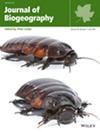The Interaction Between the Linnean and Darwinian Shortfalls Affects Our Understanding of the Evolutionary Dynamics Driving Diversity Patterns of New World Coralsnakes
Abstract
Aim
In this study, we sought to understand how the Linnean shortfall (i.e., the lack of knowledge about species taxonomy) interacts with the Darwinian shortfall (i.e., the lack of knowledge about phylogenetic relationships among species), which potentially jeopardises geographical patterns in estimates of speciation rates.
Location
New World.
Taxon
Coralsnakes (Serpentes: Elapidae).
Methods
We created an index of taxonomic uncertainty (ITU) that measures the likelihood of current species being split after undergoing future taxonomic revisions. The ITU was used in simulations where species with higher taxonomic uncertainty had a higher likelihood of having their phylogenetic branches split, generating new hypothetical species along their geographic ranges. We estimated the speciation rates before and after the split of taxonomically uncertain species.
Results
We found that a high number of coralsnake species display substantial taxonomic uncertainty, positively correlated with the latitude of the species' geographical range centroid. The estimated speciation rates based on currently available data have a weak relationship with latitude. However, after incorporating taxonomic uncertainty into the phylogeny, we detect a higher positive correlation between speciation rate and latitude.
Main Conclusions
The observed change in speciation rates following the incorporation of taxonomic uncertainty highlights how such uncertainty can undermine the empirical evaluation of geographical patterns in speciation rates, revealing an interaction between the latitudinal taxonomic gradient and the latitudinal diversity gradient. Given that taxonomic changes can alter the number of species recognised as valid over time, our study highlights the need to incorporate taxonomic uncertainty into macroecological and macroevolutionary studies, enhancing the robustness of patterns inferred from these data.

 求助内容:
求助内容: 应助结果提醒方式:
应助结果提醒方式:


